CONSTELLATION GUIDE
Last updated: 15 July 2001
CONSTELLATION GUIDE |
"GO TO"....TRIANGULUM
A Ancient Tribute to the Fertile Nile Valleys of the Pyramid Builders
From: sherrodc@ipa.net (Clay Sherrod)
This is the 23rd Constellation Guide, "GO TO TRIANGULUM" of the series "GO TO GUIDES for the ETX and LX 90 Telescope Users". Other than its fabulous "Pinwheel Galaxy," Messier 33, this small constellation is an often overlooked searching ground for deep sky splendors. Tucked in between the large constellations of Andromeda to its west and Perseus to the northeast, Triangulum offers several very nice and colorful double stars and at least two brighter "NGC-category" spiral galaxies. So all is not lost in this little corner of space. The constellation is made up of fairly faint stars to the naked eye, so use the wide field finder chart below to locate it relative to the familiar "strings" of stars in Andromeda (to the right in the chart) and the "keep-on-truckin' man" of Perseus (to the upper left in the chart).
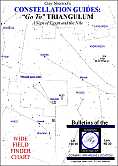
Note that the stars which form the namesake of this constellation are naked eye....but just barely. The only named star in the group, Alpha Trianguli, is "Metallah", or "Caput Trianguli" (the Latin form of the original Arabic), is only magnitude 3.49 and forms the "point" of the sharp triangle pattern. Beta Trianguli is magnitude 2.9 (or given by some as 3.1 and in either case is another example of the "beta star" of a constellation outshining the "alpha" member!); Gamma Trianguli is a full magnitude fainter, at magnitude 4.0; both Gamma and Beta for the opposite angle points of the less-than-conspicuous triangle.
Surrounding Beta Tri are two additional stars that make a nice triplet in binoculars and very low telescopic magnifications: Delta Triangulum is to the star's north and slightly fainter (still naked eye) and "7 Tri" is opposite Beta from Delta, or a bit west of due south.
The three stars making the triangle are fairly close to our own solar system, with Alpha being only 65 light years distant, followed by Gamma at about 100 light years with Beta trailing farther away at nearly 140 light years distant. They are NOT close enough to one another to be physically associated as are the stars of Orion or the Hyades in Taurus.
--------------------------------
History of the Little Triangle
Oddly enough, Triangulum is one of the original 48 constellations as set out by Ptolemy in the 2nd century A.D. Odd because it does not really fit the pattern of serving to honor myth, legend, and important Greek and Roman gods of antiquity. It is - and always has been - a "triangle." When you look upon this tiny triplet of barely-naked eye stars, it must come to mind that it should perhaps have been included in SOME OTHER constellation, like Andromeda, Cassiopeia or Perseus.
But upon closer examination, perhaps the symbol of the triangle was just as important to pre-Ptolemaic philosophers as were the gods and mythology of old. By the time that Ptolemy had designated this and other constellations by name, the Egyptian pyramids were long built and even new, smaller, ones were being constructed. The strength and grandeur of the pyramids has always captivated modern man and the reasons for their existence remains a mystery until today. So, perhaps Ptolemy was paying tribute to the engineering masterpieces of his time (and still today!).
For a brief summary of the naming and history of the constellations, see my TOUR for Lacerta at: http://www.weasner.com/etx/ref_guides/capricorn.html .
Also - again an Egyptian influence - the TRIANGULAR SHAPE of the small asterism of stars is suggestive of the earliest Greek letter for "delta," and has since been long associated with the fertile Nile River delta so vital to the advance and survival of the earliest Egyptian people. Likewise, the three stars have become associated (without any explanation as to origin) to the island of Sicily - marked in a triangle by its three conspicuous promontories which shape the island into its characteristic shape.
So, unlike the inanimate (non-animal to be more specific) constellations such as Argos (a ship), Sextans (a marine sextant), Microscopium (the microscope) and so on.....the "Triangle" is a constellation of original antiquity....the others have come since the 17th century.
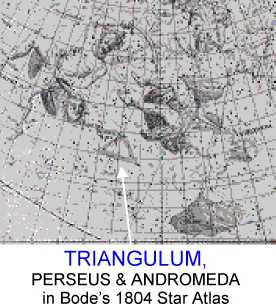
The strong influence of the triangle - plain and simply a "triangle" - can be clearly realized in the portion of the Bode star chart shown above, with Triangulum sandwiched clearly between Andromeda to its west and Perseus to its east and north. What a triangle is doing between the two lovers......who knows.
--------------------------------
Below is a closer view of Triangulum and the nice variety of objects within it for our "GO TO" TOUR. Other that about eight or ten variable stars, two dozen multiple stars and ngc/IC objects that are much too faint for amateur telescopes, what is shown in the chart is pretty much the entire menu of objects available for interesting viewing in this constellation. Nonetheless, those objects shown are quite nice and many have fantastic facts associated with them!
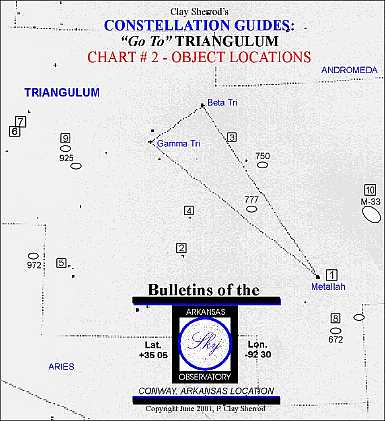
There are MANY galaxies in the realm of Triangulum, but most of these NGC objects are too faint for our telescopes and, indeed, many are beyond the reach visually of even very the largest telescopes except photographically. Hence, these galaxies (and some other faint objects of other types) are not discussed in this guide. Throughout our "GO TO" guides, only objects that are within reach of telescopes ranging from 60mm to 200mm aperture are typically discussed; occasionally you will find noted an important object or "position" that is of historical or other interest that CANNOT be seen in our telescopes.
As with all "GO TO" TOUR guide star charts, please click on this accompanying chart above to open; you can save this to file, resize to paper size and print for a nice usable desk reference or good field chart as you proceed through the Aquarius "GO TO" TOUR. PLEASE NOTE: you MUST resize the "GO TO" TOUR constellation charts from the Arkansas Sky Observatory prior to printing them! Merely save the file, open it after saving and size it to fit just as you would any document from your computer.
Also with every "GO TO" TOUR guide, each GO TO object in Triangulum is discussed for your telescope regarding the type of conditions necessary for you to view it optimally for discern the very faintest details.........magnifications and aperture necessary for most objects, and much, much more. This is YOUR complete GUIDE to get you on your way to exploring the best (and few!) objects in this constellation. The following listing of "BEST" objects contains the finest or most interesting from my own observing experience and preference.
Use the attached star chart and the following Guide as an excellent reference for your next star party itinerary, or a beginning for further study into the thousands of objects visible in this part of the sky. Truly these extensive Constellation Study Guides will most definitely put your AutoStar to work for you in the most efficient and enjoyable way possible! As a matter of fact, MANY AutoStar users are now programming their own "Tours" based on these guides, using each constellation as a separate GO TO Tour for the AutoStar library that can be added in or deleted through the main edit screen on your PC or MAC computer.
We hope you enjoy these comprehensive GUIDES to touring the constellations via your AutoStar and its computer-driven telescope. Each new installment is complete with diagrams, charts and illustrations that you will find nowhere else. Please let us hear YOUR feedback and your observations of each and every constellation after YOU have toured its vast reaches of our skies!
-----------------------------------
YOUR TRIANGULUM CONCISE DIRECTORY OF INTERESTING OBJECTS -
The close-up chart shown above will assist you in becoming familiar with the neighborhood within the little triangle. I have chosen the finest (or most interesting) 10 objects in this TRIANGULUM "GO TO" TOUR; as with all GUIDES, all objects listed below will be visible in most telescopes (some naked eye) from the ETX 60 through the LX 90; of course larger apertures may "show" an object a bit closer and "better," but frequently a wide field and low power view is more desirable than aperture for FINDING the objects initially. Indeed, I strongly encourage you first FIND the target object, or its approximate location through your GO TO function with your lowest power and then - once IDENTIFIED positively - move up slowly in steps with magnification if necessary. Remember, not all objects "like" magnification. Sometimes better "field of view" (such as the wonderful wide fields provided by the ETX 60 and 70) is desired over light gathering (like the big LX 90) and magnification.
The rule for determining "optimum magnification" is that: 1) too low power results in sky background glow detracting or diminishing the contrast against the deep sky object; 2) too high magnification darkens BOTH the sky background AND the object; 3) medium magnification can be achieved at which you have MAXIMUM contrast between the object and its darkened background sky. I have found through three decades of direct observing that about 15x per inch aperture (36x for the ETX 60/70; 55x for the ETX 90; 75x for the ETX 125; and, 125x for the LX 90).for deep sky observing is PERFECT for most objects. That being said, always remember that DOUBLE or multiple stars require whatever power you can crank out....the seeing conditions are the limiting factor here.
For my complete and comprehensive discussion regarding seeing conditions and sky transparency, see: http://www.weasner.com/etx/buyer-newuser-tips/seeing.html .
With all deep sky objects, avoid attempting to observe when the moon is in the sky, even a very thin crescent, as its brightness in the sky will overshadow the very dim contrast afforded by even the brightest deep sky object; if you see the object at all against moonlight, you will NOT see the subtle outlying areas or the full detail of what is presented.
The high northern declination of Triangulum and its very small size results in EVERY object within its borders being tightly restricted between declination +25 degrees (and only a VERY small area that far south!) and about +37 degrees, with most area and objects confined between 30 degrees and 35 degrees north declination.
Triangulum is a "fall" constellation for the northern hemisphere, rising at the end of dusk very far north of due east from mid-northern latitudes about 9:30 p.m. local time on August 7; on that same night the constellation "culminates" (or passes through the celestial meridian) at about 4:30 a.m. the next morning. Midnight culmination occurs each year on about October 20.
As with all of the "GO TO" TOUR constellation lists, I recommend a good star atlas and/or chart which will list all the finest objects, constellation-by-constellation. One very handy reference guide is the PETERSON FIELD GUIDE TO THE STARS AND PLANETS, which features complete lists with declinations, right ascensions, magnitudes, and all pertinent information for you to expand your observing horizons beyond this brief GUIDE.
Note that your AutoStar will NOT have every object listed on every constellation GO TO tour....this is intentional. You can access some of the most interesting objects of the sky directly from their coordinates. It is quite simple as you merely enter these coordinates as follows in the 10-step process:
1) Press the "MODE" key and hold down for 3 seconds and release;
2) Displayed will be the current Right Ascension and Declination of the center of field of view of where your telescope is presently pointed (assuming that you have properly aligned from "home position");
3) [NOTE: if you have the Meade electric focuser attached to any of the ETX or LX telescopes, holding down the "MODE" key will bring up the "Focus" command first....merely scroll (lower right scroll key) down one step to access the RA and DEC to enter your desired coordinates]
4) Press the "GO TO" button on AutoStar;
5) This will change the display and you will note the cursor blinking over the first digit of RIGHT ASCENSION (R.A.); merely use the number keys and dial in the R.A. of the object you are searching for;
6) When done, press "Enter;"
7) This moves the blinking cursor over the "DEC" coordinates;
8) [NOTE: the declination, unlike R.A., can be either positive or negative and you will see the "+" or "-" sign displayed depending on where your telescope is aimed at that time; if it is NOT the desired setting (plus or minus), merely use your arrow key to move the blinking cursor OVER the "+" or "-" sign and change by using either of your lower corner SCROLL KEYS;
9) Proceed to enter the DEC using number keys;
10) Press either "Enter" or "Go To" when finished and the telescope begins slewing to your desired object!!
The constellation tour Star Chart above (click on and save to a file on your PC; then open it and re-size to fit the page and print for a very handy at-the-scope star chart) will get you started on your journey for this constellation.
Following is the concise object list for your "GO TO" TOUR of AQUARIUS; you may wish to find the majority of the objects from the AutoStar Library (for example, you can easily go to the huge galaxy Messier 33 if you pull up "Object/Deep Sky/Messier/..then type in '33'...." and then press "Enter", followed by "GO TO" to access this remote globular cluster. On the other hand, if you want to experiment and become a "better AutoStar user" try entering the exact R.A. and DEC coordinates of that object as described above after holding down the MODE key. You will find the accuracy of entered GO TO's to be somewhat less than those stored in AutoStar, but the capability of acquiring unlisted objects is fantastic!
Also, remember that you can access objects in several other ways in this constellation as well:
1) by constellation: key in SETUP / OBJECT / CONSTELLATION / [scroll to Triangulum] / "Enter" / "Go To"
2) by key star: key in SETUP / OBJECT / STAR / NAMED / [scroll to "Metallah"] / Enter / Go To;
3) by Messier Object: key in SETUP / OBJECT/ DEEP SKY / MESSIER / [type in "33"] / "Enter" / "Go To"
4) by NGC object (same as #3 above, except key in "NGC" rather than "Messier" and type in "598"
5) by object name: key in SETUP / OBJECT / DEEP SKY / NAMED [scroll to "Pinwheel Galaxy...."] Enter
So here is your Triangulum concise list of objects by name and celestial coordinates:
OBJECT 1:
brighter star - METALLAH (alpha Trianguli) - R.A. 01h 50' / DEC + 29 20 - Magnitude: 3.6
OBJECT 2:
great double star - Iota Trianguli - R.A. 02h 10' / DEC + 30 04 - Mags. 5.4 & 6.9 - great colors!! Easy.
OBJECT 3:
really good double - Epsilon Tri. - R.A. 02h 00' / DEC + 33 03 - Mags: 4.4 & 11.3 - great challenge!
OBJECT 4:
fabulous double - Struve 232 - R.A. 02h 12' / DEC + 30 10 - Mags: 7.5 & 7.5 - wide, great for all scopes!
OBJECT 5:
ETX 90 test - Struve 269 - R.A. 02h 25' / DEC + 29 38 - Mags: 7.5 & 10 - great double star, close!
OBJECT 6:
another test star - Struve 285 - R.A. 02h 36' / DEC + 33 12 - Mags: 7 & 7.5 - nice equal pair, close!
OBJECT 7:
variable star - R Trianguli - R.A. 02h 34' / DEC + 34 03 - long period (266 days) Mag. 5.7 to 12.4!
OBJECT 8:
spiral galaxy - ngc672 - R.A. 01h 45' / DEC + 27 11 - Mag: 11.8 - interesting in larger scopes only
OBJECT 9:
spiral galaxy - ngc925 - R.A. 02h 24' / DEC + 33 22 - Mag: 11.4 - very large, faint! ETX 125 +
OBJECTs 10:
"Pinwheel Galaxy" - Messier 33 (ngc598) - R.A. 01h 31' / DEC + 30 24 - also ngc604 inside!
---------------------------------
A VISUAL GUIDE TO OUR DEEP SKY OBJECTS IN TRIANGULUM
Object 1 - Our "Starting" Brighter Star - "METALLAH" (alpha Trianguli)
A very close spectroscopic binary star, Metallah is a star very much like our own sun, except about 12 times more luminous. At a distance of only 65 light years, it is the closest of the few brighter stars within Triangulum, although at magnitude 3.6, it is not as bright as Beta Trianguli which shines at magnitude 3.1. Alpha Tri makes the "pointed" end of the long triangle of this constellation.
Object 2 - Iota Trianguli - A Wonderful Double Star for all telescopes!!
This is a wonderful double star for low powers in all of our telescopes, although about 50x to 75x should be used with the ETX 60 and 70. This is a well known star for its remarkable color contrasts and one that you do NOT want to pass up seeing. Most observers see two distinct colors: the brighter star (magnitude 5.4) is distinctly yellow, while the fainter star (magnitude 7.0) is clearly deep blue or green-blue. This star can be resolved with the ETX 60 and 70, but medium powers are desired to best observe the distinct colors. In all scopes be sure to use about 20x per inch aperture for best views. The companion star is just north of due east of the brighter star, separated by 3.8" arc, easily resolvable if enough magnification is used. This is a splendid sight in the ETX 90 and larger scopes.
Object 3 - Another Good Double Star - Epsilon Trianguli - Good separation, but FAINT companion!
Here is a wonderful test object for the keen-sighted ETX 60 and 70 user and a pretty darned nice object for all telescopes! Epsilon Trianguli (also "3 Tri") is a nice double with a wide magnitude contrast! it is easily found about one-third the distance from Beta Tri to Alpha Tri, along that side of the triangle. The primary star is a brighter magnitude 5.4 while the companion - a nice 3.9" separation (far enough to resolve, but close enough to make it "fun!") - is a faint magnitude 11.1, quite a challenge for the smaller scopes on a dark night. In all telescopes, best views and best chances to see the companion are with medium high (about 25x per inch to 35x per inch aperture). Look for the faint star almost exactly SOUTHEAST of the brighter star. (Position Angle 118 degrees - see: http://www.weasner.com/etx/ref_guides/lacerta.html for details regarding double star observing and determining "Position Angle")
Object 4 - A Double You Do Not Want to Miss - Twin Stars: Struve 232
Here is a "double star" that will make you think you are seeing double.....Struve 232 is a pair of EQUAL magnitude 7.5 stars,both brilliant blue-white! The stars are oriented in an almost EXACT EAST-WEST orientation, making the view even more pleasing....many have likened the view of this star at high power as "...like the headlights of a car far in the distance." The separation of this wonderful star - and its relative brightness - allows for it to be viewed easily in all telescopes. However, the colors of the stars are best appreciated at magnifications reaching 25x per inch aperture. Perhaps this star is BEST seen in the ETX 90, affording a nice field of view at about 150x plus nice contrast of their brilliant white against the dark sky.
Object 5 - The Stars are Getting Closer! Tough Double for the ETX 90 - Struve 269
Below, find a "Position Angle Chart" for both objects 5 and 6, Struve 269 and Struve 285. BOTH stars are good tests for the ETX 90 and might require the ETX 125 on some nights; neither is a simple shot with either telescope! Both stars have companions at exactly 1.6" arc, seemingly easy resolution for the larger ETX 125 but just wider than the threshold resolution of 1.3" arc for the ETX 90. Struve 269 has an easy-to-find 7.5 magnitude primary star, very orange in color. Look for the companion (use the chart below to identify where to look in the ETX and LX scopes, this being oriented exactly as your telescope with the right angle view - north at top and east to the right) in Position Angle 345 degrees....or just WEST of due NORTH. The companion is 10th magnitude, so you "might try" this star with the ETX 70 at very high power on a steady night!!
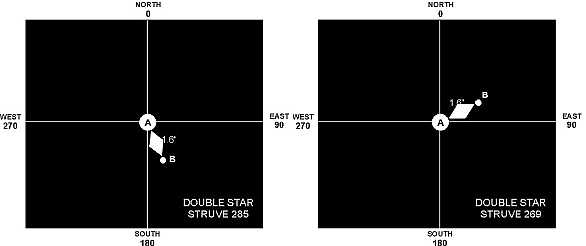
Object 6 - The Other Double Star (see above chart) - Struve 285
Like Struve 269 above, Struve 285 is a tough double, but MUCH more interesting as far as "pretty views" are concerned. Here is a pair of equal magnitude stars - 7.0 and 7.5 - VERY red in color! Look for the slightly fainter star (use the chart above to help determine where to look!) only 1.6" arc away in Position Angle 166 degrees, or just about SOUTHEAST of the brighter star. Powers of about 25x per inch minimum are recommended, and even more (up to about 40x per inch) will reveal the beautiful colors of this pair.
Object 7 - Nice Long Period Variable Star - R Trianguli
Like so many long period variables, R Trianguli is an "M-class" Red Giant star. Its variation comes from actual pulsating of its size due to expansion from the nuclear processes, and then subsequent contraction as gravity attempts to pull the mass of the star back toward its center. So dramatic is this celestial tug-of-war with this star that it will vary in magnitude from a bright 5.7 to as faint as 12.5 in only 266 days! This remarkable change can be monitored and even plotted by those using the ETX 90 telescope and certainly with larger telescopes. Reports of your observations are always valued by the American Association of Variable Star Observers (AAVSO) and you may download and print FINDER/COMPARISON charts for free from their site. To locate the star to begin your observing, use the "a" finder chart for R Trianguli at
http://charts.aavso.org/TRI/R_TRI/RTRI-A.GIF . This will allow you to see the star relative to the entire constellation and many of the brighter stars for comparison when the star is at its brightest. However, as the star fades and you need fainter comparison stars, use http://charts.aavso.org/TRI/R_TRI/RTRI-D.GIF which is the "d" narrow field chart with star magnitudes down to 13.0 and fainter.
Both charts should be downloaded and saved to a file (just name the file "R Tri"); open this file and the chart will be HUGE! Resize of course to fit your standard 8.5 x 11 inch page and RE-SAVE the file in your new format. Then you may print each of these charts and laminate or put in a sheet protector for use in the night air.
Object 8 - A Faint Spiral Galaxy - NGC 672
For lack of a better description, this is a "rugged" spiral galaxy; the ETX 125 and LX 90 "may" show some clumping of this object, this being the conglomerated star groups that are lumped tightly in a couple of the spiral arms. Although this faint galaxy is a medium sized object (5.5' by 1.5' arc), it is very faint and seen best only on VERY dark nights; wait until the object is nearly overhead for viewing. It is possible to see this galaxy in the ETX 90 as a very small dim glow in about 150x magnification if your skies are very dark. Look for this very faint galaxy just south of Alpha Trianguli.
Object 9 - Another Faint Spiral Galaxy - NGC 925
This object - like ngc672 above - is a very "rugged" spiral galaxy, exhibiting bright clumpings in the spiral arms from huge star clusters. The clusters cannot be seen, but the clumping CAN be seen in the LX 90. This, like ngc672 is a very faint galaxy, but it is much larger - 9.5' x 4.3' arc - and hence perhaps easier to spot in the ETX 90, though a challenge. This galaxy forms an isosceles triangle with Gamma and Beta Tri., being just EAST of Gamma.
Object 10 - The Famous "Triangulum Galaxy" or "Pinwheel Galaxy" - Messier 33
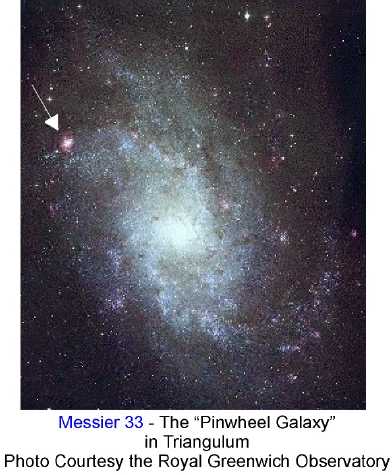
You are looking at perhaps the MOST DISTANT object in all of space that can be seen with the naked eye! Messier 33 is just a bit farther from us than its more famous cousin, the Andromeda Galaxy, Messier 31, found only a few degrees WEST of M-33. The Hipparcos satellite surveys have changed the cosmic distance scale, and has resulted in "moving out" the distance to M33 to about 3.0 million light years. Most sources give a distance of 2.3 to 2.4 million light years, but the Sky Catalogue 2000 has more than 2.9 million light years. Compare that distance to slightly neared Messier 31 at a distance of some 2.3 million light years; both are part of the same gravitationally-bound "Local Group" of galaxies (see http://www.weasner.com/etx/ref_guides/lacerta.html ).
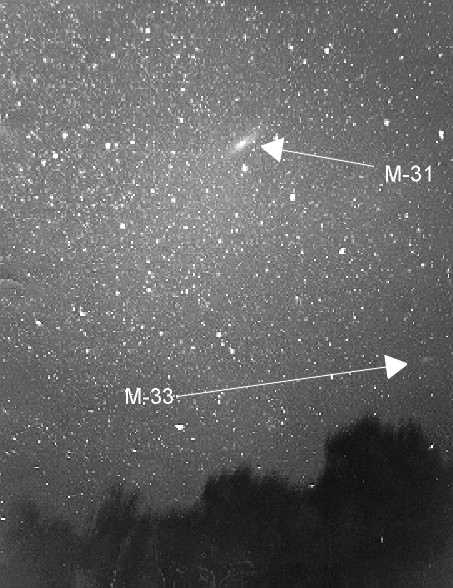
Credit for the first records of M-33 is given to astronomer Hodierna in about 1654; like so many celestial "discoveries" of the time, this beautiful galaxy was independently rediscovered by Messier in 1764. Sir William Herschel, who otherwise carefully avoided Messier's objects in his survey, assigned it the number HERSCHEL V.17, on September 11, 1784. Also because of the cataloging of Herschel, the brightest NGC object embedded within this galaxy - NGC 604 - has received an NGC number of its own. This interesting "clump" of celestial material is PART OF Messier 33 and is situated in the northeastern part of the galaxy; it is the bright knot near the top of the image shown below in the NASA photographs; the photo at right shows the region very close through the eyes of Hubble, resolving over 200 young hot massive stars (of 15 to 60 solar masses) which have recently formed here. This region in the Pinwheel galaxy is MUCH like our own Milky Way's Orion region, a stellar birthing place and nursery for young hot stars.
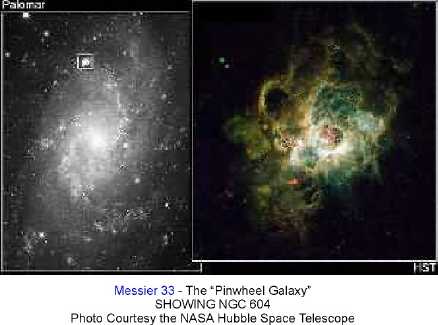
Messier 33 gives our ETX 60 and 70 users a BIG advantage over the larger telescopes. Because M-33 is so large - 65' a 35' arc (twice as large as the moon's apparent diameter long and just the same size as it wide!) - and so faint, this object is best viewed always with very wide field and low power instruments; in standard 10 x 50 binoculars on dark mountaintops, this thing is huge and bright! It appears as a "thumbprint of a glow". I always thought that binoculars were "the way to go" when viewing this close galaxy UNTIL I had a chance to see it through the ETX 70....just outstanding! Just as with the large wide field needed with observing Messier 31, the ETX 60 and 70 provide the sharpest contrast and widest fields imaginable; combined with their very fast focal ratios, the images are truly outstanding. With the ETX 90, use as wide a field as possible, preferably the 32mm Plossl if possible; the ETX 125 and LX 90 warrant an even wider field eyepiece; my 35mm Televue Panoptic gives and incredible 1.4 degree field of view with the 8" scope and takes in all of the Pinwheel, though not M-31. On the ETX 125, I have found that the 40mm Super Plossl is by far the best for this object, with my 32mm Televue Plossl giving it some competition with somewhat better star images across the field.
This is an excellent object for piggyback astrophotography (see my discussion about piggyback photography at: http://www.weasner.com/etx/ref_guides/astrophotography.html ) requiring about a 200mm telephoto lens, dark sky and some "fast" film rated at about ASA 400 or above.
Just to the north of direct center of this large galaxy is NGC 604, which is NOT a separate object at all (see the photograph and locator arrows above); this is actually a huge cloud of dust, gas and stars embedded in one of the larger spiral arms of M-33, very similar to the Orion nebula here in our Milky Way. The ETX 125 on the darkest of nights can SEE this, if you know exactly where to look; it will look as an incredibly faint "ragged" fuzzy star at about 200x, due north about 1/2 field of view in the 26mm Plossl. It shows up better (brighter) with no additional detail visible in the LX 90 at about the same magnification, although it can be seen easier in this scope at somewhat lower powers.
--------------------------------
WANDERING ABOUT....YOUR NEW "USER OBJECT" IN TRIANGULUM
What did I tell you....this tiny constellation is just PACKED with good objects; other than the fabulous Messier 33, there are NOT that many interesting deep sky objects, but there are plenty more doubles to be observed for the curious. Consult the Burnham's Celestial Handbook, Volume 3 for additional double and multiple stars - as well as several other good variable stars for our telescopes.
One such multiple star will be our TRIANGULUM USER OBJECT for this constellation "GO TO" TOUR. This is the quadruple star "Struve 158" this being the 158th multiple star cataloged by the pioneering visual double star observer Otto Struve throughout the early 20th century. Struve 158 is a difficult star to locate....once found though, it is unmistakable - there will be two faint stars, one ("A") at magnitude 8.5 and the other ("B") slightly dimmer at magnitude 9.1 (just for starters!) The separation of these two stars is ONLY 2.1 second of arc, but still easily resolvable in the ETX 90; the trick here is to make sure of the identify at low power and then gradually move up to higher magnifications to achieve both images (about 30x per inch minimum).
Locate Struve 158 at: R.A. 01h 44m ; +32 degrees 55m.
[mike - "" here - diagram of quad star]
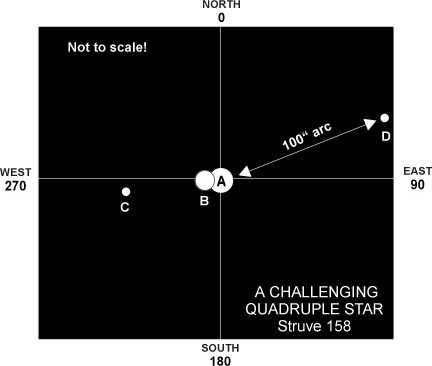
As shown in my diagram "B" is in Position Angle 267 degrees, or almost exactly DUE WEST of the brighter star; that should aid in its identification. The brighter "A" star has another companion, "C" with a VERY faint magnitude 12.5 (likely NOT visible in the ETX 90 but attainable in the ETX 125) in Position Angle 256 degrees, ALSO nearly DUE WEST! However, look for this very faint star (use about 40x per inch in the 5" and 8" scopes) much farther away, some 50" arc, or about the diameter Jupiter would look in the same eyepiece. There is yet a FOURTH member of the multiple Struve 158, this being not quite so faint as "C", at magnitude 11.4, hence easily visible in the ETX 90. This "D" star is TWICE the distance (100" arc) from "A" that "C" is, but is found nearly opposite the brightest star, in Position Angle 70 degrees, just north of EAST (see the finder chart above).
On AutoStar, go to: "Select/Object [enter]...." scroll down to "User Object" [ enter]. Now enter the coordinates given above for "Struve 158", using the number keys on AutoStar. After entering the coordinates and pressing "Enter" yet again, scroll down one and you can list the magnitude of the object as "8"[Enter].
You will likely be glad you have added this object to your library of AutoStar User Objects: first, you will likely NOT see all four stars at your first attempt and be tempted to move onto something easier ("....I know! let's look at the Pinwheel Galaxy!"); second if you DO see all four stars then you will surely want to show off your trophy catch!, and third, if you cannot resolve all four stars, you will want to remember this challenge when you move up to a larger telescope!
Next Constellation GO TO" TOUR Installment: ARIES - the first constellation of the Zodiac, the mighty Ram of the sky compressed into is small stoned quarry of night sky.
Until then, good Observing and may your nights be calm and your nights be deep!
P. Clay Sherrod
Arkansas Sky Observatory
Conway / Petit Jean Mountain
Arkansas
Return to the top of this page.
Go back to the Observational Guides & References page.
Go back to my ETX Home Page.